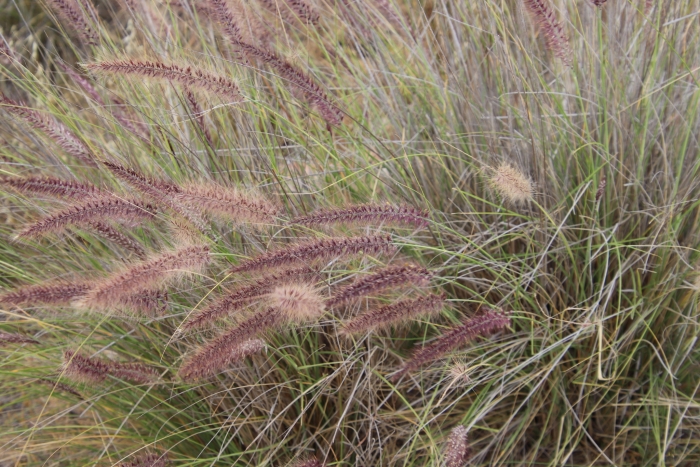Crimson Fountaingrass
(Cenchrus setaceus)
Crimson Fountaingrass (Cenchrus setaceus)
/
/

Millie Basden
CC BY 4.0
Image By:
Millie Basden
Recorded By:
Copyright:
CC BY 4.0
Copyright Notice:
Photo by: Millie Basden | License Type: CC BY 4.0 | License URL: http://creativecommons.org/licenses/by/4.0/ | Rights Holder: Millie Basden | Publisher: iNaturalist | Date Created: 2021-05-02T15:48:55-07:00 |
















































Estimated Native Range
Summary
Cenchrus setaceus, commonly known as Crimson Fountaingrass, is a deciduous perennial grass native to open, sandy areas in sub-Saharan Africa, the Middle East, and Southwest Asia. It typically grows to a height of 4 feet (1.2 meters) and a width of 2-3 feet (0.6-0.9 meters). This ornamental grass is characterized by its clumping habit and showy, purplish-pink flower spikes that appear in summer and persist into fall, providing a long season of visual interest. The foliage is narrow and arching, with a green to burgundy color that complements the vibrant flower plumes.
Crimson Fountaingrass is valued for its low water requirements, rapid growth rate, and striking flower displays, making it a popular choice for xeriscaping, rock gardens, and as an accent plant in borders. It thrives in full sun or part shade and prefers well-drained soils. While it is drought-tolerant, it can also adapt to various soil types, provided they have good drainage. However, due to its invasive nature, it is not recommended for planting in areas where it can spread uncontrollably. In regions where it is not invasive, it can be managed by deadheading to prevent self-seeding.CC BY-SA 4.0
Crimson Fountaingrass is valued for its low water requirements, rapid growth rate, and striking flower displays, making it a popular choice for xeriscaping, rock gardens, and as an accent plant in borders. It thrives in full sun or part shade and prefers well-drained soils. While it is drought-tolerant, it can also adapt to various soil types, provided they have good drainage. However, due to its invasive nature, it is not recommended for planting in areas where it can spread uncontrollably. In regions where it is not invasive, it can be managed by deadheading to prevent self-seeding.CC BY-SA 4.0
Plant Description
- Plant Type: Grass
- Height: 3-4 feet
- Width: 2-3 feet
- Growth Rate: Moderate
- Flower Color: N/A
- Flowering Season: Summer
- Leaf Retention: Deciduous
Growth Requirements
- Sun: Full Sun, Part Shade
- Water: Low
- Drainage: Fast, Medium
Common Uses
Border Plant, Deer Resistant, Drought Tolerant, Low Maintenance, Rock Garden, Salt Tolerant
Natural Habitat
Open, sandy areas in sub-Saharan Africa, the Middle East, and Southwest Asia
Other Names
Common Names: African Fountain Grass , Fountaingrass , Yerba De Fuente
Scientific Names: Pennisetum setaceum , Pennisetum cupreum , Cenchrus setaceus , Pennisetum ruppellii , Pennisetum tiberiadis , Pennisetum parisii , Pennisetum erythraeum , Pennisetum rueppelianum , Pennisetum orientale subsp. parisii , Pennisetum setaceum var. parisii
GBIF Accepted Name: Cenchrus setaceus (Forssk.) Morrone